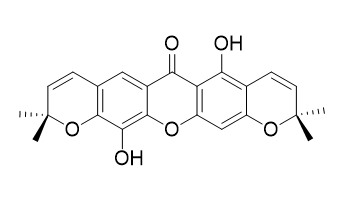Pyranojacareubin
Pyranojacareubin is a natural product from Calophyllum inophyllum.
Inquire / Order:
manager@chemfaces.com
Technical Inquiries:
service@chemfaces.com
Tel:
+86-27-84237783
Fax:
+86-27-84254680
Address:
1 Building, No. 83, CheCheng Rd., Wuhan Economic and Technological Development Zone, Wuhan, Hubei 430056, PRC
Providing storage is as stated on the product vial and the vial is kept tightly sealed, the product can be stored for up to
24 months(2-8C).
Wherever possible, you should prepare and use solutions on the same day. However, if you need to make up stock solutions in advance, we recommend that you store the solution as aliquots in tightly sealed vials at -20C. Generally, these will be useable for up to two weeks. Before use, and prior to opening the vial we recommend that you allow your product to equilibrate to room temperature for at least 1 hour.
Need more advice on solubility, usage and handling? Please email to: service@chemfaces.com
The packaging of the product may have turned upside down during transportation, resulting in the natural compounds adhering to the neck or cap of the vial. take the vial out of its packaging and gently shake to let the compounds fall to the bottom of the vial. for liquid products, centrifuge at 200-500 RPM to gather the liquid at the bottom of the vial. try to avoid loss or contamination during handling.
PLoS One.2022, 17(6):e0268505.
Molecules.2022, 27(22):7887.
Int J Mol Sci.2024, 25(5):2914.
Molecular & Cellular Toxicology 2024, 00444-8.
Chem Biol Interact.2022, 368:110248.
Front Pharmacol.2019, 10:1025
J Agric Food Chem.2017, 65(13):2670-2676
Indian J Pharm Sci.2024, 86(2):736-741.
BMC Complement Altern Med.2018, 18(1):303
J Chromatogr B Analyt Technol Biomed Life Sci.2018, 1080:27-36
Related and Featured Products
Ugaxanthone
Catalog No: CFN96469
CAS No: 13179-11-8
Price: Inquiry(manager@chemfaces.com)
Isojacareubin
Catalog No: CFN96573
CAS No: 50597-93-8
Price: Inquiry(manager@chemfaces.com)
1,3,6,8-tetrahydroxy-4-(3-methyl-2-buten-1-yl)-9H-Xanthen-9-one
Catalog No: CFN92541
CAS No: 1319198-98-5
Price: Inquiry(manager@chemfaces.com)
6-Deoxyjacareubin
Catalog No: CFN96276
CAS No: 16265-56-8
Price: Inquiry(manager@chemfaces.com)
1,3,7-Trihydroxy-2-prenylxanthone
Catalog No: CFN98022
CAS No: 20245-39-0
Price: Inquiry(manager@chemfaces.com)
1,7-Dihydroxy-3-methoxy-2-prenylxanthone
Catalog No: CFN97264
CAS No: 77741-58-3
Price: Inquiry(manager@chemfaces.com)
1,5,8-Trihydroxy-3-methoxy-2-prenylxanthone
Catalog No: CFN99202
CAS No: 110187-11-6
Price: Inquiry(manager@chemfaces.com)
1,4,5,6-Tetrahydroxy-7-prenylxanthone
Catalog No: CFN99016
CAS No: 1001424-68-5
Price: Inquiry(manager@chemfaces.com)
1,4,6-Trihydroxy-5-methoxy-7-prenylxanthone
Catalog No: CFN99675
CAS No: 160623-47-2
Price: Inquiry(manager@chemfaces.com)
O-Demethylforbexanthone
Catalog No: CFN97493
CAS No: 92609-77-3
Price: Inquiry(manager@chemfaces.com)
Pak J Pharm Sci. 2015 Mar;28(2):425-9.
Antiproliferative xanthone derivatives from Calophyllum inophyllum and Calophyllum soulattri.[Pubmed:
25730799]
METHODS AND RESULTS:
Structure-activity relationships of eleven xanthones were comparatively predicted for four cancer cell lines after the compounds were subjected to antiproliferative assay against B-lymphocyte cells (Raji), colon carcinoma cells (LS174T), human neuroblastoma cells (IMR-32) and skin carcinoma cells (SK-MEL-28). The eleven chemical constituents were obtained naturally from the stem bark of Calophyllum inophyllum and Calophyllum soulattri. Inophinnin (1) and inophinone (2) were isolated from Calophyllum inophyllum while soulattrin (3) and phylattrin (4) were found from Calophyllum soulattri. The other xanthones were from both Calophyllum sp. and they are Pyranojacareubin (5), rheediaxanthone A (6), macluraxanthone (7), 4-hydroxyxanthone (8), caloxanthone C (9), brasixanthone B (10) and trapezifolixanthone (11).
CONCLUSIONS:
Compound 3 was found to be the most cytotoxic towards all the cancer cell lines with an IC50 value of 1.25μg/mL while the simplest xanthone, compound 8 was inactive.
J Asian Nat Prod Res. 2011 Oct;13(10):956-60.
A new furanoxanthone from the stem bark of Calophyllum inophyllum.[Pubmed:
21972812 ]
METHODS AND RESULTS:
The stem bark extracts of Calophyllum inophyllum furnished one new furanoxanthone, inophinnin (1), in addition to inophyllin A (2), macluraxanthone (3), Pyranojacareubin (4), 4-hydroxyxanthone, friedelin, stigmasterol, and betulinic acid. The structures of these compounds were determined by spectroscopic analysis of 1D and 2D NMR spectral data ((1)H, (13)C, DEPT, COSY, HMQC, and HMBC) while EI-MS gave the molecular mass.
CONCLUSIONS:
The new xanthone, inophinnin (1), exhibited some anti-inflammatory activity in nitric oxide assay.



